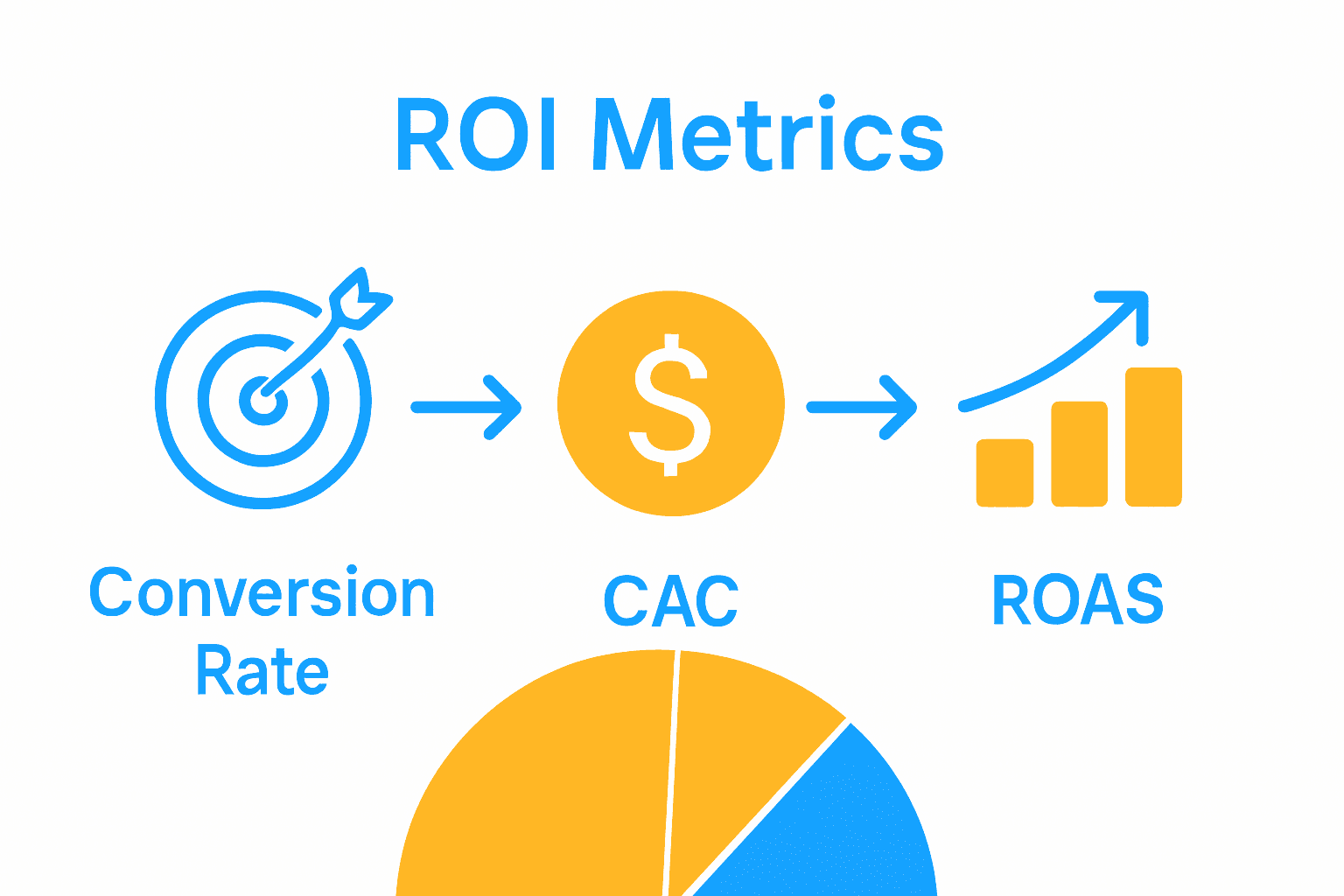More than 60 percent of businesses struggle to prove the true impact of their digital marketing efforts. Understanding digital marketing ROI is no longer just a buzzword, it is a direct route to smarter spending and stronger profits. By learning how to measure what matters and track campaign performance with precision, you can make informed choices that boost growth and cut waste in an increasingly competitive online world.
Table of Contents
- Defining Digital Marketing ROI And Core Concepts
- Essential ROI Metrics For Digital Campaigns
- Best Practices For Data Collection And Analysis
- Challenges In Measuring ROI Accurately
- Strategies To Optimize And Improve ROI
Key Takeaways
| Point | Details |
|---|---|
| Understanding ROI Metrics | Digital marketing ROI measures the profitability of marketing efforts by comparing revenue to costs, while ROMI focuses on specific campaign performance. |
| Data Collection Best Practices | Implementing structured data collection and consistent tracking is vital for accurate ROI assessment in digital marketing. |
| Challenges in Measurement | Businesses often struggle with multi-channel attribution and data fragmentation, complicating the accurate measurement of digital marketing ROI. |
| Strategies for Optimization | Continuous A/B testing and focusing on key performance indicators like Conversion Rate can significantly enhance digital marketing ROI. |
Defining Digital Marketing ROI and Core Concepts
Digital marketing ROI represents the measurement of profitability and effectiveness of marketing efforts in the digital landscape. According to Universal Business Council, ROI is calculated by comparing revenue generated against marketing costs: ROI = (Revenue – Cost) / Cost × 100. This powerful metric allows businesses to understand precisely how their digital marketing investments translate into financial returns.
Return on Marketing Investment (ROMI) provides a nuanced view of marketing performance. As Metric HQ explains, ROMI evaluates the revenue generated from specific marketing campaigns relative to their total investment. The formula, ROMI = (Attributable Revenue – Campaign Investment) / Campaign Investment, helps organisations track the direct financial impact of their marketing strategies.
Key components of digital marketing ROI include:
- Tracking revenue directly attributable to marketing efforts
- Measuring cost per acquisition
- Calculating conversion rates
- Assessing customer lifetime value
- Understanding channel-specific performance
By comprehensively analysing these metrics, businesses can make data-driven decisions, optimise marketing spend, and strategically allocate resources for maximum impact. Understanding digital advertising basics can further enhance your ability to interpret and improve marketing ROI.
Essential ROI Metrics for Digital Campaigns
Digital marketing success hinges on understanding and tracking key performance indicators. According to Universal Business Council, the most critical metrics for evaluating digital marketing performance include Return on Investment (ROI), Return on Ad Spend (ROAS), Customer Acquisition Cost (CAC), Conversion Rate, Cost per Lead (CPL), and Engagement Rate. These metrics provide comprehensive insights into campaign efficiency, customer engagement, and overall profitability.
Conversion Rate and Click-Through Rate (CTR) are particularly crucial indicators of campaign effectiveness. As Imarticus explains, these metrics reveal how many visitors complete a desired action and how many users interact with your digital advertisements. Higher values in these metrics signify successful engagement and campaign performance.

Key ROI metrics businesses should track include:

- Conversion Rate: Percentage of visitors completing a desired action
- Customer Acquisition Cost (CAC): Total cost of acquiring a new customer
- Return on Ad Spend (ROAS): Revenue generated per marketing dollar spent
- Click-Through Rate (CTR): Percentage of users clicking on an advertisement
- Engagement Rate: Level of interaction with digital content
To gain deeper insights into digital marketing strategies, Discover Top Metrics to Measure Digital Marketing Success can provide additional context and advanced tracking techniques for businesses seeking to optimise their digital marketing performance.
Best Practices for Data Collection and Analysis
Data collection and analysis are critical foundations for accurately measuring digital marketing ROI. According to Universal Business Council, effective measurement requires a structured approach that involves setting clear goals, meticulously tracking all costs, and precisely assigning value to marketing outcomes.
The key to robust data collection lies in leveraging advanced tracking technologies and analytical tools. Unified tracking mechanisms like UTM parameters enable marketers to trace the precise origin of website traffic and conversions. Professional-grade analytics platforms such as Google Analytics and comprehensive Customer Relationship Management (CRM) systems provide deep insights into campaign performance, allowing businesses to dissect and understand complex marketing interactions.
Essential best practices for digital marketing data collection include:
- Define clear, measurable objectives before launching campaigns
- Implement consistent tracking parameters
- Use multi-channel attribution models
- Integrate data from multiple sources
- Regularly clean and validate data sets
- Establish baseline metrics for comparison
For businesses looking to enhance their analytical capabilities, What Is Digital Marketing? Complete Overview for Business offers comprehensive insights into developing a strategic approach to digital marketing measurement and analysis.
Challenges in Measuring ROI Accurately
Measuring digital marketing ROI is far more complex than simple number-crunching. According to The MASB, businesses face significant challenges in accurately attributing sales to specific campaigns, accounting for external factors influencing consumer behavior, and distinguishing between short-term and long-term marketing impacts.
Data fragmentation emerges as a critical obstacle in ROI measurement. As research from IJRAR highlights, the complexity stems from scattered data across multiple platforms, rapidly evolving consumer behaviors, and the inherent difficulty in quantifying intangible outcomes like brand awareness. These challenges demand sophisticated analytical approaches that go beyond traditional linear measurement techniques.
Key challenges in digital marketing ROI measurement include:
- Multi-channel attribution complexity
- Difficulty tracking cross-platform consumer journeys
- Isolating specific campaign impacts
- Accounting for indirect marketing influences
- Measuring brand perception and long-term value
- Handling data inconsistencies across different platforms
To navigate these complexities, businesses can leverage advanced analytical tools and integrated data systems. Top Digital Marketing Channels for Success in 2025 provides additional insights into developing comprehensive measurement strategies that address these intricate ROI calculation challenges.
Strategies to Optimize and Improve ROI
Optimizing digital marketing ROI requires a strategic approach focused on actionable metrics and continuous improvement. According to Universal Business Council, businesses should prioritize key performance indicators like Conversion Rate and Customer Lifetime Value (LTV) to refine strategies that enhance revenue and long-term growth potential.
Continuous experimentation is crucial for ROI enhancement. As WebPeak emphasizes, data-driven optimization through systematic A/B testing and performance reviews ensures marketing efforts remain aligned with business objectives. This approach involves rigorously testing different elements such as ad creatives, landing page designs, and communication strategies to incrementally improve campaign effectiveness.
Key strategies for improving digital marketing ROI include:
- Implement comprehensive A/B testing
- Focus on high-value customer segments
- Develop detailed customer personas
- Optimize conversion funnel continuously
- Invest in targeted remarketing campaigns
- Leverage advanced analytics for insights
For businesses seeking deeper insights into strategic marketing approaches, Internet Marketing by Cloudfusion offers comprehensive guidance on developing robust digital marketing strategies that drive measurable business outcomes.
Unlock True Value from Your Digital Marketing Investments
Measuring digital marketing ROI presents many businesses with tough challenges such as tracking multi-channel attribution and isolating campaign impacts. This can lead to frustration when it feels like your efforts do not translate clearly into tangible growth. The article highlights common pain points including difficulty attributing revenue accurately and managing complex data streams. Concepts like conversion rate, customer acquisition cost, and campaign investment are essential yet often overwhelming to implement without expert guidance.
At Cloudfusion, we understand these hurdles and offer custom solutions that transform how you approach digital success. Our web design and development quotation service focuses on creating scalable, data-driven websites tailored to optimise your marketing funnels and maximise ROI. By combining strategic branding, advanced analytics integration, and continuous optimisation, we help you achieve clear measurement and improved campaign results.
Take control of your digital marketing performance today. Discover how bespoke development aligned with your specific goals can simplify ROI tracking and accelerate growth. Visit Cloudfusion now and request your personalised web design and development quotation to start turning your marketing data into measurable success.
Frequently Asked Questions
What is digital marketing ROI?
Digital marketing ROI measures the profitability and effectiveness of marketing efforts in the digital landscape by comparing revenue generated against marketing costs. It is calculated using the formula ROI = (Revenue – Cost) / Cost × 100.
How can I calculate Return on Marketing Investment (ROMI)?
ROMI can be calculated using the formula ROMI = (Attributable Revenue – Campaign Investment) / Campaign Investment, which helps evaluate the revenue generated from specific marketing campaigns relative to their investments.
What are the essential metrics to track for measuring digital marketing success?
Key metrics include Return on Investment (ROI), Return on Ad Spend (ROAS), Customer Acquisition Cost (CAC), Conversion Rate, Cost per Lead (CPL), and Engagement Rate. These metrics provide insights into campaign efficiency and overall profitability.
What challenges do businesses face when measuring digital marketing ROI?
Challenges include multi-channel attribution complexity, difficulties in tracking cross-platform consumer journeys, isolating specific campaign impacts, and managing data fragmentation. These issues require sophisticated analytical approaches for accurate measurement.








